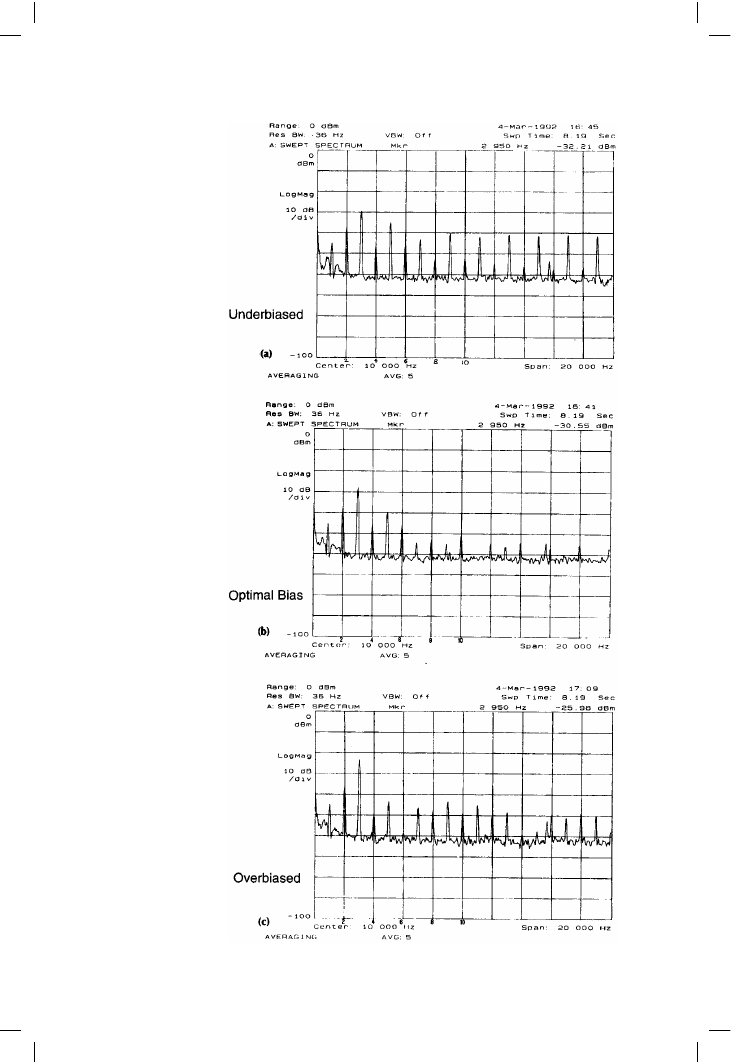ВУЗ: Казахская Национальная Академия Искусств им. Т. Жургенова
Категория: Учебное пособие
Дисциплина: Не указана
Добавлен: 03.02.2019
Просмотров: 17388
Скачиваний: 18

The small signal stages
amplifier, at the full voltage swing, is the prime suspect for generating a
major part of its non-linearity. In actual fact, this is unlikely to be true, and
if we select for an amplifier a cascode VAS with current-source collector-
load and buffer it from the output stage, or use a beta-enhancer in the VAS,
the second of our eight distortions is usually negligible.
References
1. Gray and Meyer Analysis and Design of Analog Integrated Circuits
Wiley 1984, p. 172 (exponential law of singleton).
2. Gray and Meyer ibid, p. 194 (tanh law of simple pair).
3. Self Sound Mosfet Design Electronics and Wireless World, Sept 1990,
p. 760 (varying input balance with R2).
4. Gray and Meyer ibid, p. 256 (tanh law of current-mirror pair).
5. Feucht Handbook of Analog Circuit Design Academic Press 1990,
p. 432 (Cross-quad).
6. Quinn IEEE International Solid-State Circuits Conference, THPM 14.5,
p. 188 (Cascomp).
7. Gray and Meyer Analysis and Design of Analog Integrated Circuits
Wiley 1984, p. 251 (VAS transfer characteristic).
8. Antognetti (Ed) Power Integrated Circuits McGraw-Hill 1986 (see page
201).
9. Gray and Meyer Analysis and Design of Analog Integrated Circuits
Wiley 1984, p. 252 (Rco limit on VAS gain).
10. Self Sound Mosfet Design Electronics and Wireless World Sept 1990,
p. 760.
11. Oliver Distortion In Complementary-Pair Class-B Amplifiers Hewlett-
Packard Journal, Feb 1971, p. 11.
12. Linsley-Hood, J Solid State Audio Power – 3 Electronics and Wireless
World, Jan 1990, p. 16.
13. Borbely A 60 W MOSFET Power Amplifier The Audio Amateur, Issue 2,
1982, p. 9.
14. Hefley High Fidelity, Low Feedback, 200 W Electronics and Wireless
World, June 92 p. 454.
105

5
The output stage I
Classes and devices
The almost universal choice in semiconductor power amplifiers is for a
unity-gain output stage, and specifically a voltage-follower. Output stages
with gain are not unknown – see Mann
[1]
for a design with ten times gain
in the output section – but they have significantly failed to win popularity.
Most people feel that controlling distortion while handling large currents is
quite hard enough without trying to generate gain at the same time.
In examining the small-signal stages, we have so far only needed to deal
with one kind of distortion at a time, due to the monotonic transfer
characteristics of such stages, which usually (but not invariably
[2]
) work in
Class A. Economic and thermal realities mean that most output stages are
Class B, and so we must now also consider crossover distortion, (which
remains the thorniest problem in power amplifier design) and HF switchoff
effects.
We must also decide what kind of active device is to be used; JFETs offer
few if any advantages in the small-current stages, but power FETS in the
output appear to be a real possibility, providing that the extra cost proves to
bring with it some tangible benefits.
The most fundamental factor in determining output-stage distortion is the
Class of operation. Apart from its inherent inefficiency, Class-A is the ideal
operating mode, because there can be no crossover or switchoff distortion.
However, of those designs which have been published or reviewed, it is
notable that the large-signal distortion produced is still significant. This
looks like an opportunity lost, as of the distortions enumerated in Chapter
3, we now only have to deal with Distortion 1 (input-stage), Distortion 2
(VAS), and distortion 3 (output-stage large-signal non-linearity). Distortions
4, 5, 6 and 7, as mentioned earlier, are direct results of Class-B operation
106

The output stage I
and therefore can be thankfully disregarded in a Class-A design. However,
Class-B is overwhelmingly of the greater importance, and is therefore dealt
with in detail below.
Class B is subject to much misunderstanding. It is often said that a pair of
output transistors operated without any bias are working in Class-B, and
therefore generate severe crossover distortion. In fact, with no bias each
output device is operating for slightly less than half the time, and the
question arises as to whether it would not be more accurate to call this
Class-C and reserve Class-B for that condition of quiescent current which
eliminates, or rather minimises, the crossover artefacts.
There is a further complication; it is not generally appreciated that moving
into what is usually called Class-AB, by increasing the quiescent current,
does not make things better. In fact, if the output power is above the level
at which Class-A operation can be sustained, the THD reading will
certainly increase as the bias control is advanced. This is due to what is
usually called gm-doubling (i.e. the voltage-gain increase caused by both
devices conducting simultaneously in the centre of the output-voltage
range, that is, in the Class-A region) putting edges into the distortion
residual that generate high-order harmonics much as under-biasing does.
This vital fact seems almost unknown, presumably because the gm-
doubling distortion is at a relatively low level and is completely obscured
in most amplifiers by other distortions.
This phenomenon is demonstrated in Figure 5.1a, b and c, which shows
spectrum analysis of the distortion residuals for under-biasing, optimal, and
over-biasing of a 150 W/8 ! amplifier at 1 kHz. As before, all non-
linearities except the unavoidable Distortion 3 (output stage) have been
effectively eliminated. The over-biased case had its quiescent current
increased until the gm-doubling edges in the residual had an approximately
50:50 mark/space ratio, and so was in Class-A about half the time, which
represents a rather generous amount of quiescent current for Class-AB.
Nonetheless, the higher-order odd harmonics in Figure 5.1c are at least
10 dB greater in amplitude than those for the optimal Class-B case, and the
third harmonic is actually higher than for the under-biased case as well.
However the under-biased amplifier, generating the familiar sharp spikes
on the residual, has a generally greater level of high-order odd harmonics
above the fifth; about 8 dB higher than the AB case.
Since high-order odd harmonics are generally considered to be the most
unpleasant, there seems to be a clear case for avoiding Class-AB altogether,
as it will always be less efficient and generate more high-order distortion
than the equivalent Class-B circuit as soon as it leaves Class-A. Class
distinction seems to resolve itself into a binary choice between A or B.
It must be emphasised that these effects are only visible in an amplifier
where the other forms of distortion have been properly minimised. The
107

Audio Power Amplifier Design Handbook
108
Figure 5.1
Spectrum analysis of
Class-B and AB
distortion residual

The output stage I
RMS THD reading for Figure 5.1a was 0.00151%, for Figure 5.1b
0.00103%, and for Figure 5.1c 0.00153%. The tests were repeated at the
40 W power level with very similar results. The spike just below 16 kHz is
interference from the testgear VDU.
This is complex enough, but there are other and deeper subtleties in Class-
B, which are dealt with below.
The distortions of the output
I have called the distortion produced directly by the output stage Distortion
3 (see page 64) and this can now be subdivided into 3 categories.
Distortion 3a describes the large-signal distortion that is produced by both
Class-A and B, ultimately because of the large current swings in the active
devices; in bipolars, but not FETs, large collector currents reduce the beta,
leading to drooping gain at large output excursions. I shall use the term LSN
for Large-Signal Non-linearity, as opposed to crossover and switchoff
phenomena that cause trouble at all output levels.
These other two contributions to Distortion 3 are associated with Class-B
and AB only; Distortion 3b is classic crossover distortion, resulting from the
non-conjugate nature of the output characteristics, and is essentially non-
frequency dependent. In contrast, Distortion 3c is switchoff distortion,
generated by the output devices failing to turn off quickly and cleanly at
high frequencies, and is very strongly frequency-dependent. It is sometimes
called switching distortion, but this allows room for confusion, as some
writers use switching distortion to cover crossover distortion as well; hence
I have used the term switchoff distortion to refer specifically to charge-
storage turn-off troubles. Since Class-B is almost universal, and introduces
all three kinds of non-linearity, we will concentrate on this.
Harmonic generation by crossover distortion
The usual non-linear distortions generate most of their unwanted energy in
low-order harmonics that NFB can deal with effectively. However,
crossover and switching distortions that warp only a small part of the output
swing tend to push energy into high-order harmonics, and this important
process is demonstrated here, by Fourier analysis of a SPICE waveform.
Taking a sinewave fundamental, and treating the distortion as an added
error signal E, let the ratio WR describe the proportion of the cycle where
E is non-zero. If this error is a triangle-wave extending over the whole cycle
(WR = 1) this would represent large-signal nonlinearity, and Figure 5.2
shows that most of the harmonic energy goes into the third and fifth
harmonics; the even harmonics are all zero due to the symmetry of the
waveform.
109